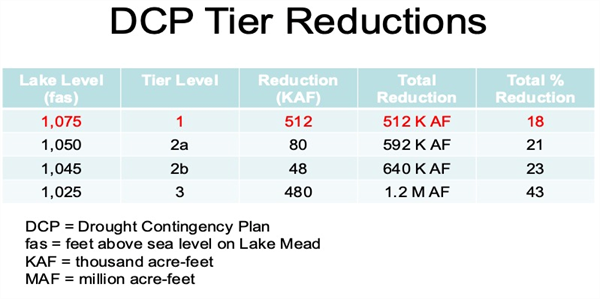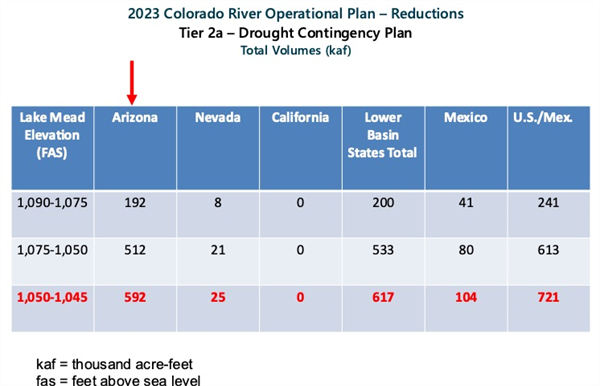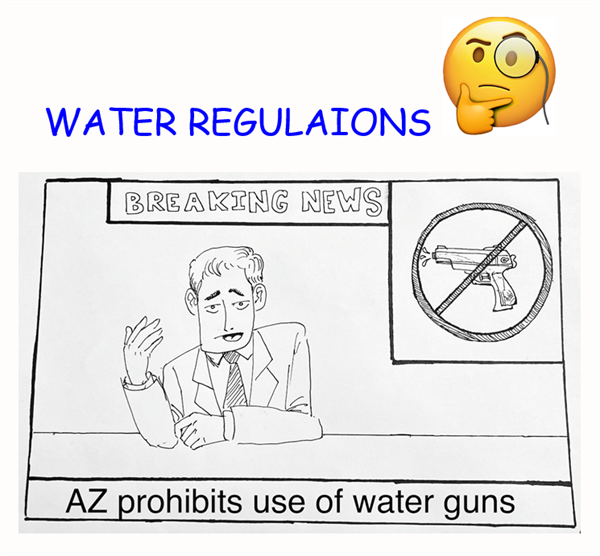
As Colorado River flows have decreased over the past 23 years due to the prolonged drought, many proposals have been presented for management of the river. One group from the research community presented some intriguing scenarios last year with a publication in Science on 22 July 2022 (Wheeler et al., 2022).
I found some of their points and suggestions interesting in relation to the Colorado River management discussions. These recommendations are not reflected in the recent U.S. Bureau of Reclamation (USBR) operational plans for 2024 that were presented with their 24-Month study reports and projections (USBR, 15 August 2023). It will be interesting to see if these points become part of the negotiations in the next two years for the interstate and international shortage agreements that expire in 2026.
Basic parameters for any proposed management plans of the Colorado River must include the “Law of the River” which is an amalgam of interstate compacts, court decrees, federal laws, secretarial guidelines, and an international treaty with Mexico. Key elements associated with the Law of the River include the 1922 Colorado River Compact among the seven basin states in the United States and the 1944 Treaty between the United States and Mexico.
The 1922 Colorado River Compact divided the watershed into upper and lower basins with the dividing point at Lees Ferry in Arizona. Each basin was allocated 7.5 million acre-feet (MAF) per year. The 1944 Treaty established a delivery requirement of 1.5 MAF/year to Mexico. Thus, a total of 16.5 MAF/year is allocated from the Colorado River.
The 1922 Compact negotiators based their work on an assumption of 17.5 MAF/year of river flow. However, the 20thcentury average natural flow rates on the Colorado River have been 15.2 MAF/year, resulting in an approximate 2.3 MAF/year structural deficit. This deficit in the water budget for the Colorado River and evaporation losses were never corrected in a formal manner, primarily due to some states not using their full allocations.
Changes in the climate since 2000 have resulted in much drier conditions in the Colorado River watershed with reduced annual natural flows to an average of 12.3 MAF/year. Thus, the challenge in addressing the shortages on the Colorado River is that of basic mass balance and developing a consumptive use water budget that matches water supply in the river.
Like many people working in agriculture, I have been watching and studying the situation with great interest. Based on my understanding, one of the key issues in the negotiations has been the differences in perspectives between the upper and lower basin states.
The lower basin states and Mexico have been fully utilizing their water allocations from the Colorado River in contrast to the upper basin which has not been using its full 7.5 MAF/year allocation. For example, between 2000 and 2020 the upper basin consumptive use averaged 3.7 MAF/year plus at least 0.7 MAF/year of reservoir evaporation. The upper basin states have plans for further development and utilization of their full allocation and they want to protect their Colorado River water allocation to support these development plans.
Agriculture is responsible for approximately 70% of the Colorado River water use. As noted by the USBR (2015), the lower basin has been irrigating less than one-half of the area irrigated by the upper basin, but the agricultural revenues of the lower basin are more than three times that of the upper basin.
Additional upper basin development and water use from the river exposes a much higher level of uncertainty on Colorado River water management for the future and there are concerns that it could violate the non-depletion obligation in the 1922 Compact which states the upper basin will not deplete the river’s flow to less than 75 MAF during any 10-year consecutive period. This implies an assumption on the part of the 1922 Compact negotiators that a short-term drought could be managed within a 10-year period, but we are now dealing with drought extending over 23 years. In addition, the 1944 Treaty requires all seven states to share in the obligation to Mexico.
The upper basin states have been adamant that the responsibility of balancing the shortages on the river rests fully with the lower basin states and Mexico. The upper basin states have also consistently emphasized the importance of equality between basins as outlined in the Compact but that has not actually happened in 100 years.
The upper basin representatives have proposed reductions in lower basin water use of 1.2 – 1.5 MAF, which is a reduction of about 17-22%. In addition, upper basin states suggest that evaporation losses from the river system should be subtracted out of the lower basin allocations.
On the other hand, important economic and equity considerations must also be recognized and a good argument exists that the loss of an established agricultural industry in the lower basin is much more harmful than reducing plans for future development in the upper basin. Thus, the proposed development in the upper basin is being questioned and appropriately so in my view.
Wheeler et al. (2022) ran a series of hydrological models, including the USBR Colorado River Simulation System (CRSS, 2021) and developed a set of 100 scenarios. More details are provided in their article (Wheeler et al., 2022).
In my review of the work presented by Wheeler et al., there are two scenarios that are particularly intriguing, outlined in Tables 1 and 2.
|
Basin |
Proposed Consumptive Use |
Percent of Full Allocation |
|
Upper |
4.5 |
60% of full allocation and0.8 MAF > recent use |
|
Lower |
6.0 |
66.7% of full allocation |
Table 1. The first scenario presented in the Wheeler et al. (2022) article.
|
Basin |
Proposed Consumptive Use |
Percent of Full Allocation |
|
Upper |
4.0 |
53% of full allocation and0.3 MAF > recent use |
|
Lower |
7.0 |
77.8% of full allocation |
Table 2. The second scenario presented in the Wheeler et al. (2022) article.
Both scenarios represent significant reductions in Colorado River water allocations to balance consumptive use with recent natural flow rates. But the fact remains that the mass balance of natural Colorado River flow and consumptive must be dealt with to realize a sustainable system of management. All these scenarios present major challenges in implementation.
For 2024, the operational plans for the Colorado River are basically the Tier 1 plans from the 2019 Drought Contingency Plan (USBR, 2023; Table 3). Tier 1 reductions include an 18% reduction in Colorado River water use by Arizona and approximately 3 MAF of additional water is being held in Lake Mead by voluntary reductions from several Arizona municipalities.
In 2023, Tier 2a guidelines were in effect in 2023 and Arizona has been dealing with a 592,000 AF allocation, which is a 21% reduction of the 2.8 MAF full allocation (Table 4). Thus, Arizona, Mexico, and other lower basin states have already been meeting the reduction requirements outlined in the second scenario described above (Table 2).

Table 3. Drought Contingency Plans (DCP) for Arizona, Tiers 1-3. Tier 1
reductions (red) will be in place in 2024.

Table 4. Drought Contingency Plan for lower basin states and Mexico, rows are
Tier 0, Tier 1, and Tier 2a. Arizona is highlighted with the red arrow and Tier 2a
for all lower basin states and Mexico in red letters.
The consideration of scenarios such as the ones described by Wheeler et al. offer some good points for consideration over the next two years as all interstate and international shortage agreements expire in 2026. The negotiations in the next two years will be challenging and any proposal offered will meet resistance, particularly under the conditions of the Colorado River after 23 years of serious drought and the high level of demand that exists in the basin.
Reference
USBR. 2015. “Moving Forward Effort: Phase 1 Report” (DOI, May 2015); https://www.usbr.gov/lc/region/programs/crbstudy/MovingForward
USBR. 2021. “DRAFT CRSS: Key modeling assumptions, June 2021 model” (DOI, 2021); http://bor.colorado.edu/Public_web/CRSTMWG/CRSS.
USBR, 15 August 2023. 24-Month Study reports.
August 2023 Lake Powell and Lake Mead: End of Month Elevation Charts
Wheeler, K.G., B. Udall, J. Wang, E. Kuhn, H. Salehabadi, and J. C. Schmidt. 2022. What will it take to stabilize the Colorado River? Science, 377 (6604), DOI: 10.1126/science.abo4452
https://www.science.org/doi/10.1126/science.abo4452c
Frost and freeze damage affect countless fruit and vegetable growers leading to yield losses and occasionally the loss of the entire crop. Frost damage occurs when the temperature briefly dips below freezing (32°F).With a frost, the water within plant tissue may or may not actually freeze, depending on other conditions. A frost becomes a freeze event when ice forms within and between the cell walls of plant tissue. When this occurs, water expands and can burst cell walls. Symptoms of frost damage on vegetables include brown or blackening of plant tissues, dropping of leaves and flowers, translucent limp leaves, and cracking of the fruit. Symptoms are usually vegetable specific and vary depending on the hardiness of the crop and lowest temperature reached. A lot of times frost injury is followed by secondary infection by bacteria or opportunist fungi confusing with plant disease.
Most susceptible to frost and freezing injury: Asparagus, snap beans, Cucumbers, eggplant, lemons, lettuce, limes, okra, peppers, sweet potato
Moderately susceptible to frost and freezing injury: Broccoli, Carrots, Cauliflower, Celery, Grapefruit, Grapes, Oranges, Parsley, Radish, Spinach, Squash
Least susceptible to frost and freezing injury: Brussels sprouts, Cabbage, Dates, Kale, Kohlrabi, Parsnips, Turnips, Beets
More information:
Shallowing steaming soil for weed control in spinach and baby leaf lettuce crops – machine in action and trial results (>89% weed control) video. Watch it here!
Fig. 1. Steam applicator principally comprising a 63 BHP steam generator
mounted on a bed-shaper applicator sled for killing weed seed prior to planting.
Steam applicator injects steam as beds are formed.After cooling (< ½ a day), the
crop is planted into the disinfested soil.
Do you know the botanical families of all the small acreage specialty crops grown in the low desert?
The family is an important factor in deciding what type of herbicides can be used for weed control in our crops. For some of us it has been difficult to keep track of the families. I found a table published in this Newsletter by our Applied Weed Science maestro Barry Tickes.
Hope you like the chart with the botanical families of many of these crops and herbicides that might be used on them.
|
Botanical |
Crops |
Possible herbicides |
|
Brassica |
Bok Choy, Napa, Mizuna, Kale, Kohlrabi, Turnip Greens, Mustard, Tatsoi, Arugula, Radish, Daikon |
Prefar, Trifluralin, Dacthal, Stinger, Poast, Select |
|
Umbelliferae |
Cilantro, Celery, Coriander, Parsley, Dill, Parsnip, Fennel |
Prefar, Lorox, Poast, Prometryne |
|
Aster |
Endive, Escarole, Chicory, Radicchio |
Prefar, Trifluralin, Kerb, Fusilade, Poast, Select |
|
Amaranth |
Spinach, Chard, Beets |
Roneet, Dual Magnum, Poast, Select |

Results of pheromone and sticky trap catches can be viewed here.
Corn earworm: CEW moth counts remain at low levels in all areas, well below average for this time of year.
Beet armyworm: Trap increased areawide; above average compared to previous years.
Cabbage looper: Cabbage looper counts decreased in all areas; below average for this time of season.
Diamondback moth: DBM moth counts decreased in most areas. About average for this time of the year.
Whitefly: Adult movement beginning at low levels, average for early spring.
Thrips: Thrips adult counts reached their peak for the season. Above average compared with previous years.
Aphids: Aphid movement decreased in all areas; below average for late-March.
Leafminers: Adults remain low in most locations, below average for March.